HI5017 Management Accounting: Case Study Analysis - Cost Decisions
VerifiedAdded on 2023/03/31
|16
|3320
|316
Case Study
AI Summary
This management accounting case study analyzes various cost-related decisions for a proposed childcare business. It examines different types of costs, including variable, fixed, and operating costs, and evaluates factors influencing the purchase of new appliances versus outsourcing laundry services. The study compares the costs of laundering clothes through different options, such as using a laundry service, a laundromat, or purchasing appliances. It also assesses the financial implications of hiring an employee, considering salary, maintenance, insurance, and meal expenses, and analyzes the potential revenue increase. Furthermore, the case explores the financial considerations of relocating the daycare, comparing the costs and revenues of operating from home versus a new location. The analysis helps in understanding the financial impact of each decision, enabling informed business choices.
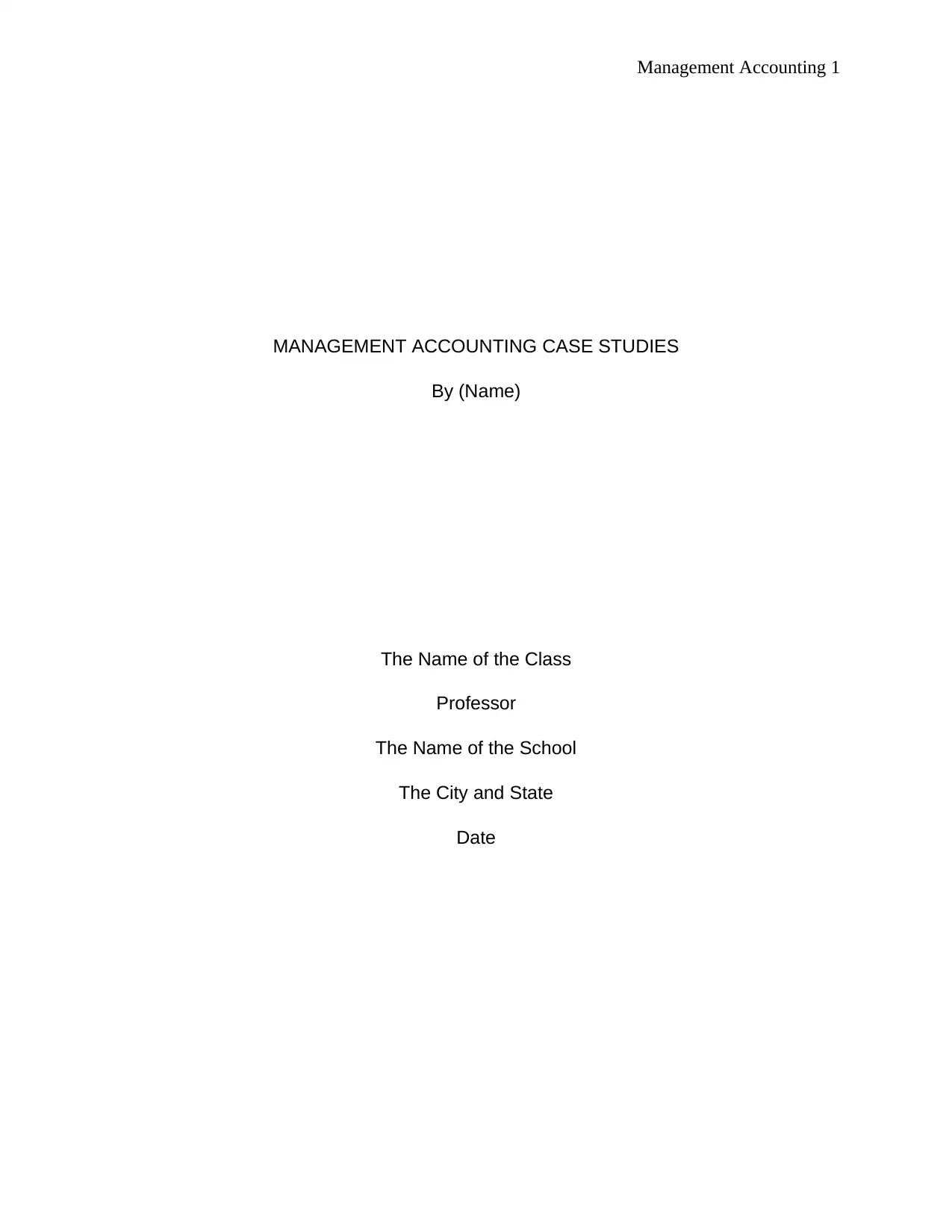
Management Accounting 1
MANAGEMENT ACCOUNTING CASE STUDIES
By (Name)
The Name of the Class
Professor
The Name of the School
The City and State
Date
MANAGEMENT ACCOUNTING CASE STUDIES
By (Name)
The Name of the Class
Professor
The Name of the School
The City and State
Date
Paraphrase This Document
Need a fresh take? Get an instant paraphrase of this document with our AI Paraphraser
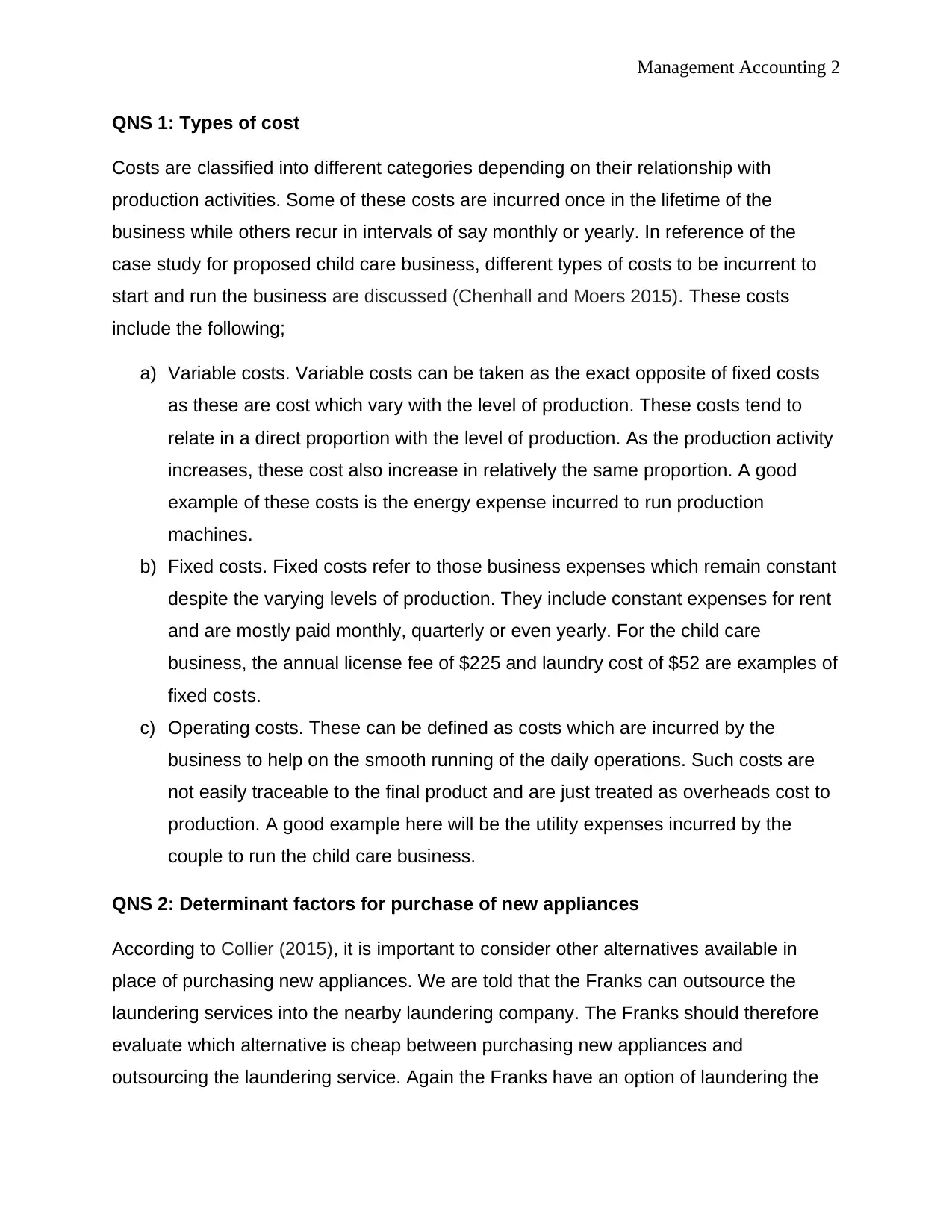
Management Accounting 2
QNS 1: Types of cost
Costs are classified into different categories depending on their relationship with
production activities. Some of these costs are incurred once in the lifetime of the
business while others recur in intervals of say monthly or yearly. In reference of the
case study for proposed child care business, different types of costs to be incurrent to
start and run the business are discussed (Chenhall and Moers 2015). These costs
include the following;
a) Variable costs. Variable costs can be taken as the exact opposite of fixed costs
as these are cost which vary with the level of production. These costs tend to
relate in a direct proportion with the level of production. As the production activity
increases, these cost also increase in relatively the same proportion. A good
example of these costs is the energy expense incurred to run production
machines.
b) Fixed costs. Fixed costs refer to those business expenses which remain constant
despite the varying levels of production. They include constant expenses for rent
and are mostly paid monthly, quarterly or even yearly. For the child care
business, the annual license fee of $225 and laundry cost of $52 are examples of
fixed costs.
c) Operating costs. These can be defined as costs which are incurred by the
business to help on the smooth running of the daily operations. Such costs are
not easily traceable to the final product and are just treated as overheads cost to
production. A good example here will be the utility expenses incurred by the
couple to run the child care business.
QNS 2: Determinant factors for purchase of new appliances
According to Collier (2015), it is important to consider other alternatives available in
place of purchasing new appliances. We are told that the Franks can outsource the
laundering services into the nearby laundering company. The Franks should therefore
evaluate which alternative is cheap between purchasing new appliances and
outsourcing the laundering service. Again the Franks have an option of laundering the
QNS 1: Types of cost
Costs are classified into different categories depending on their relationship with
production activities. Some of these costs are incurred once in the lifetime of the
business while others recur in intervals of say monthly or yearly. In reference of the
case study for proposed child care business, different types of costs to be incurrent to
start and run the business are discussed (Chenhall and Moers 2015). These costs
include the following;
a) Variable costs. Variable costs can be taken as the exact opposite of fixed costs
as these are cost which vary with the level of production. These costs tend to
relate in a direct proportion with the level of production. As the production activity
increases, these cost also increase in relatively the same proportion. A good
example of these costs is the energy expense incurred to run production
machines.
b) Fixed costs. Fixed costs refer to those business expenses which remain constant
despite the varying levels of production. They include constant expenses for rent
and are mostly paid monthly, quarterly or even yearly. For the child care
business, the annual license fee of $225 and laundry cost of $52 are examples of
fixed costs.
c) Operating costs. These can be defined as costs which are incurred by the
business to help on the smooth running of the daily operations. Such costs are
not easily traceable to the final product and are just treated as overheads cost to
production. A good example here will be the utility expenses incurred by the
couple to run the child care business.
QNS 2: Determinant factors for purchase of new appliances
According to Collier (2015), it is important to consider other alternatives available in
place of purchasing new appliances. We are told that the Franks can outsource the
laundering services into the nearby laundering company. The Franks should therefore
evaluate which alternative is cheap between purchasing new appliances and
outsourcing the laundering service. Again the Franks have an option of laundering the

Management Accounting 3
cloths by themselves. This option comes with additional costs of purchasing the
detergents and fabric sheets. The Franks should consider all the costs associated to
each option and then decide on the cheapest alternative.
The information about the old appliances which have already stopped working is not
necessary in this decision. The cost of the old appliances is a sunk cost and it is not
needed in making the decision of whether to purchase new appliances or outsource the
laundering services (Zsambok 2014). This is because the decision should be based on
the available alternative solutions to the problem at hand. The only information which is
important to this decision is the one that offers an option to solving the problem of
laundering the business’s cloths.
QNS 3: Cost of laundering clothes and Red Oak.
First option: taking clothes to red oak laundry and dry cleaning co.
Cost= U$ 50 monthly.
Second option: taking clothes to Laundromat
Total cost incurred in doing laundry at Laundromat include;
Laundering cost=cost of washing clothes per week*number of weeks in a month
= U$ 8*4.33 =34.64 per month
Transportation=mileage rate*number of mile
=U$ 0.56 per mile*6 mile (to and fro) = U$ 3.36 per week.
Monthly cost=transportation cost per week*number of weeks in a month
= 3.36 per week × 4.33 weeks = $ 14.55 per month.
Detergent or fabric sheets per month = 1/4 cost of detergents subtracted from 3 months
= $ 35/3 = U$ 11.66 per month.
cloths by themselves. This option comes with additional costs of purchasing the
detergents and fabric sheets. The Franks should consider all the costs associated to
each option and then decide on the cheapest alternative.
The information about the old appliances which have already stopped working is not
necessary in this decision. The cost of the old appliances is a sunk cost and it is not
needed in making the decision of whether to purchase new appliances or outsource the
laundering services (Zsambok 2014). This is because the decision should be based on
the available alternative solutions to the problem at hand. The only information which is
important to this decision is the one that offers an option to solving the problem of
laundering the business’s cloths.
QNS 3: Cost of laundering clothes and Red Oak.
First option: taking clothes to red oak laundry and dry cleaning co.
Cost= U$ 50 monthly.
Second option: taking clothes to Laundromat
Total cost incurred in doing laundry at Laundromat include;
Laundering cost=cost of washing clothes per week*number of weeks in a month
= U$ 8*4.33 =34.64 per month
Transportation=mileage rate*number of mile
=U$ 0.56 per mile*6 mile (to and fro) = U$ 3.36 per week.
Monthly cost=transportation cost per week*number of weeks in a month
= 3.36 per week × 4.33 weeks = $ 14.55 per month.
Detergent or fabric sheets per month = 1/4 cost of detergents subtracted from 3 months
= $ 35/3 = U$ 11.66 per month.
⊘ This is a preview!⊘
Do you want full access?
Subscribe today to unlock all pages.

Trusted by 1+ million students worldwide
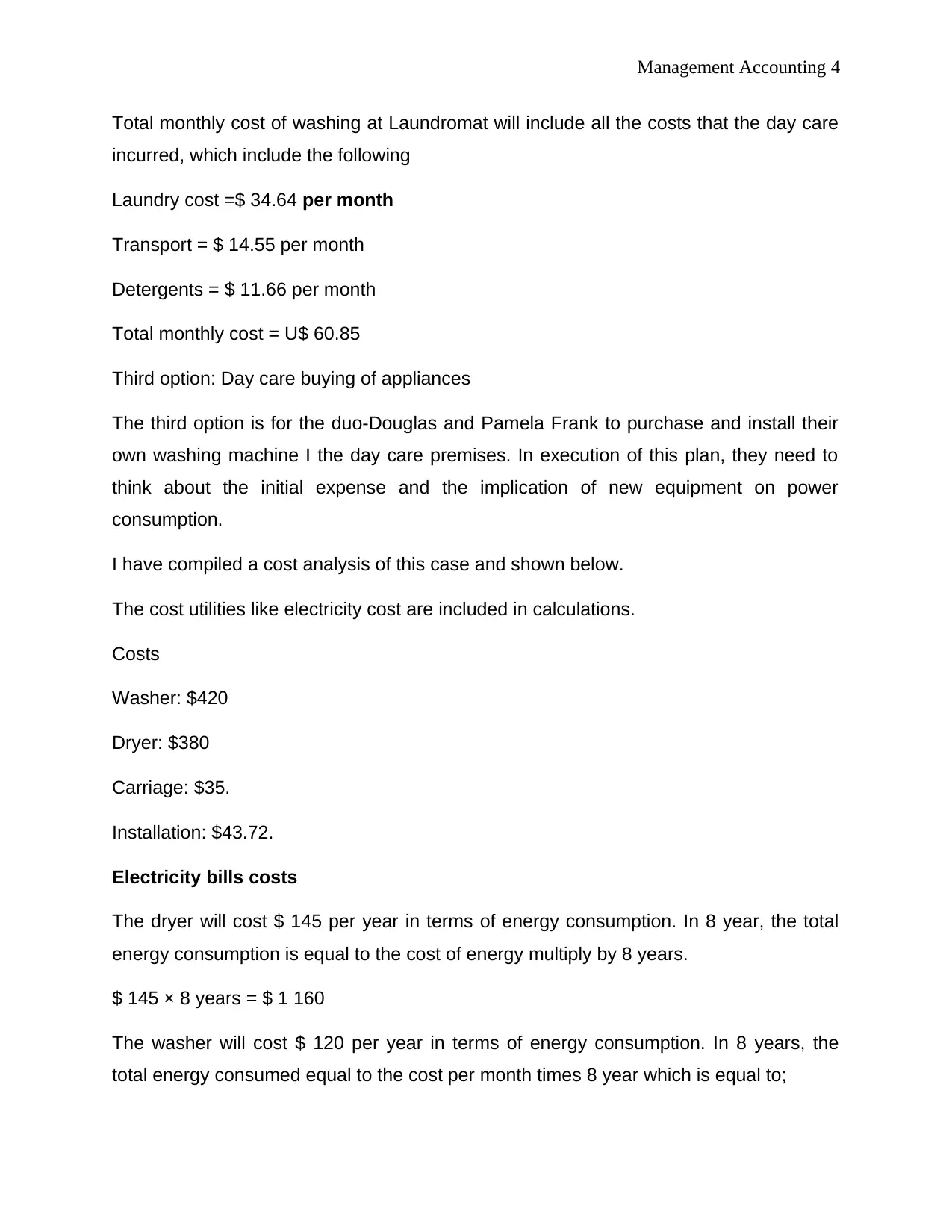
Management Accounting 4
Total monthly cost of washing at Laundromat will include all the costs that the day care
incurred, which include the following
Laundry cost =$ 34.64 per month
Transport = $ 14.55 per month
Detergents = $ 11.66 per month
Total monthly cost = U$ 60.85
Third option: Day care buying of appliances
The third option is for the duo-Douglas and Pamela Frank to purchase and install their
own washing machine I the day care premises. In execution of this plan, they need to
think about the initial expense and the implication of new equipment on power
consumption.
I have compiled a cost analysis of this case and shown below.
The cost utilities like electricity cost are included in calculations.
Costs
Washer: $420
Dryer: $380
Carriage: $35.
Installation: $43.72.
Electricity bills costs
The dryer will cost $ 145 per year in terms of energy consumption. In 8 year, the total
energy consumption is equal to the cost of energy multiply by 8 years.
$ 145 × 8 years = $ 1 160
The washer will cost $ 120 per year in terms of energy consumption. In 8 years, the
total energy consumed equal to the cost per month times 8 year which is equal to;
Total monthly cost of washing at Laundromat will include all the costs that the day care
incurred, which include the following
Laundry cost =$ 34.64 per month
Transport = $ 14.55 per month
Detergents = $ 11.66 per month
Total monthly cost = U$ 60.85
Third option: Day care buying of appliances
The third option is for the duo-Douglas and Pamela Frank to purchase and install their
own washing machine I the day care premises. In execution of this plan, they need to
think about the initial expense and the implication of new equipment on power
consumption.
I have compiled a cost analysis of this case and shown below.
The cost utilities like electricity cost are included in calculations.
Costs
Washer: $420
Dryer: $380
Carriage: $35.
Installation: $43.72.
Electricity bills costs
The dryer will cost $ 145 per year in terms of energy consumption. In 8 year, the total
energy consumption is equal to the cost of energy multiply by 8 years.
$ 145 × 8 years = $ 1 160
The washer will cost $ 120 per year in terms of energy consumption. In 8 years, the
total energy consumed equal to the cost per month times 8 year which is equal to;
Paraphrase This Document
Need a fresh take? Get an instant paraphrase of this document with our AI Paraphraser
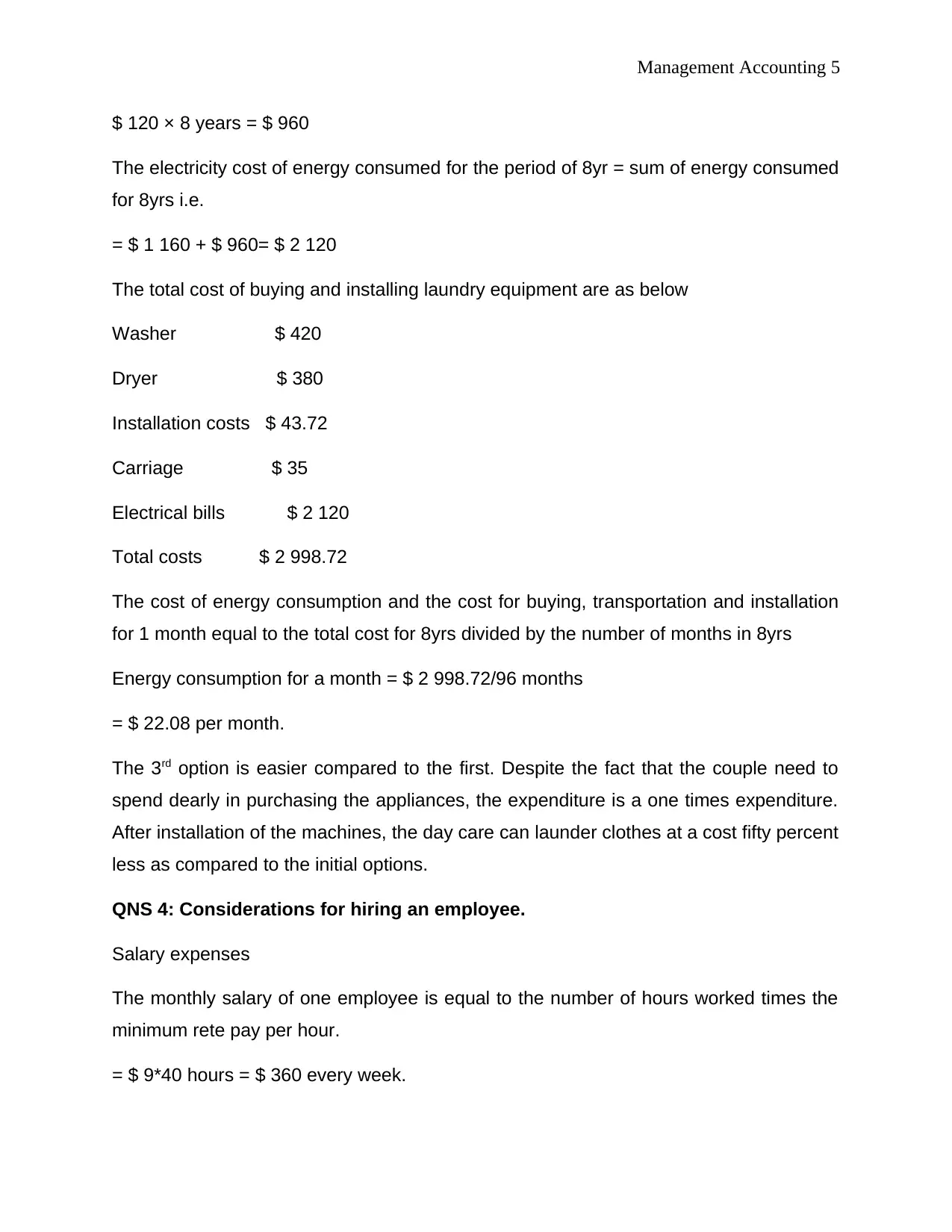
Management Accounting 5
$ 120 × 8 years = $ 960
The electricity cost of energy consumed for the period of 8yr = sum of energy consumed
for 8yrs i.e.
= $ 1 160 + $ 960= $ 2 120
The total cost of buying and installing laundry equipment are as below
Washer $ 420
Dryer $ 380
Installation costs $ 43.72
Carriage $ 35
Electrical bills $ 2 120
Total costs $ 2 998.72
The cost of energy consumption and the cost for buying, transportation and installation
for 1 month equal to the total cost for 8yrs divided by the number of months in 8yrs
Energy consumption for a month = $ 2 998.72/96 months
= $ 22.08 per month.
The 3rd option is easier compared to the first. Despite the fact that the couple need to
spend dearly in purchasing the appliances, the expenditure is a one times expenditure.
After installation of the machines, the day care can launder clothes at a cost fifty percent
less as compared to the initial options.
QNS 4: Considerations for hiring an employee.
Salary expenses
The monthly salary of one employee is equal to the number of hours worked times the
minimum rete pay per hour.
= $ 9*40 hours = $ 360 every week.
$ 120 × 8 years = $ 960
The electricity cost of energy consumed for the period of 8yr = sum of energy consumed
for 8yrs i.e.
= $ 1 160 + $ 960= $ 2 120
The total cost of buying and installing laundry equipment are as below
Washer $ 420
Dryer $ 380
Installation costs $ 43.72
Carriage $ 35
Electrical bills $ 2 120
Total costs $ 2 998.72
The cost of energy consumption and the cost for buying, transportation and installation
for 1 month equal to the total cost for 8yrs divided by the number of months in 8yrs
Energy consumption for a month = $ 2 998.72/96 months
= $ 22.08 per month.
The 3rd option is easier compared to the first. Despite the fact that the couple need to
spend dearly in purchasing the appliances, the expenditure is a one times expenditure.
After installation of the machines, the day care can launder clothes at a cost fifty percent
less as compared to the initial options.
QNS 4: Considerations for hiring an employee.
Salary expenses
The monthly salary of one employee is equal to the number of hours worked times the
minimum rete pay per hour.
= $ 9*40 hours = $ 360 every week.
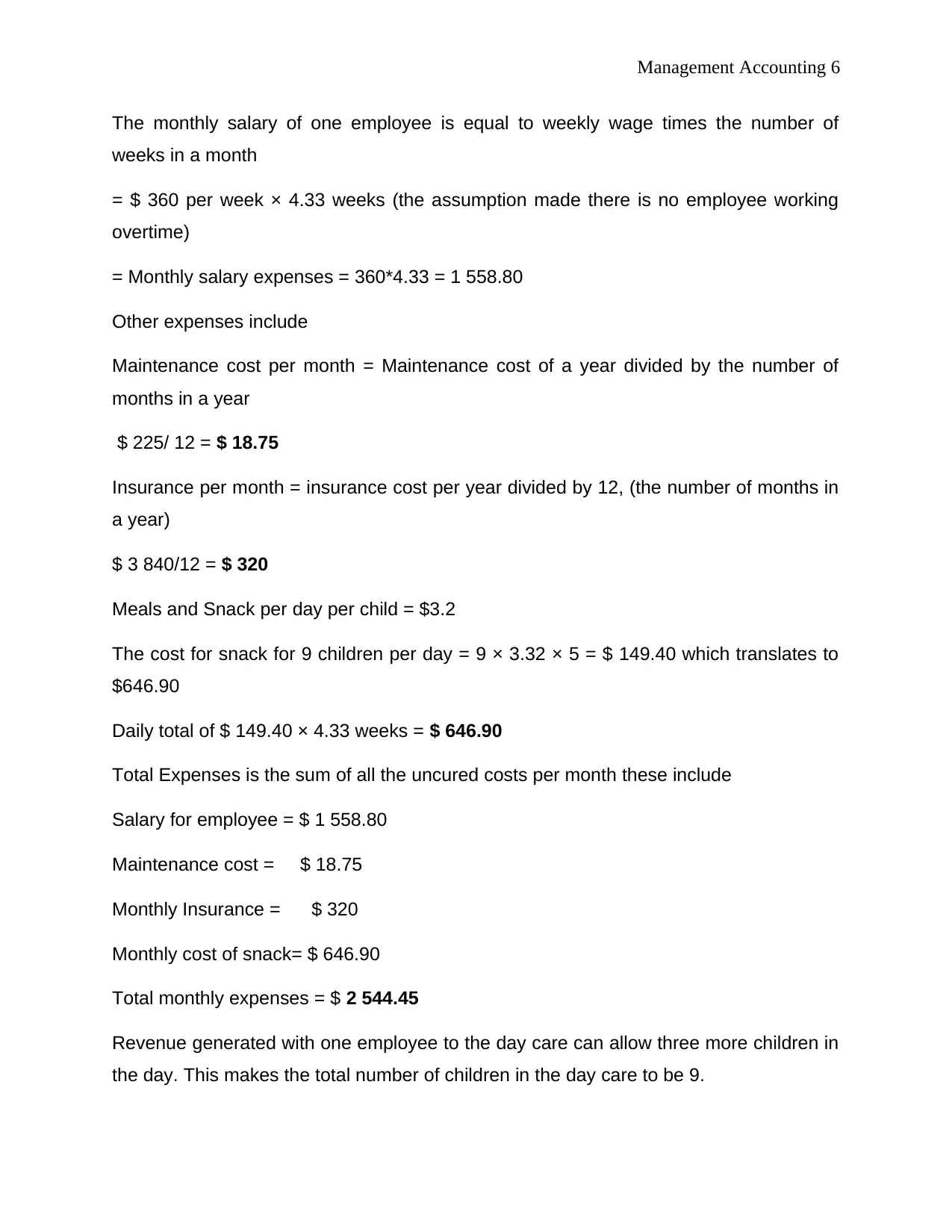
Management Accounting 6
The monthly salary of one employee is equal to weekly wage times the number of
weeks in a month
= $ 360 per week × 4.33 weeks (the assumption made there is no employee working
overtime)
= Monthly salary expenses = 360*4.33 = 1 558.80
Other expenses include
Maintenance cost per month = Maintenance cost of a year divided by the number of
months in a year
$ 225/ 12 = $ 18.75
Insurance per month = insurance cost per year divided by 12, (the number of months in
a year)
$ 3 840/12 = $ 320
Meals and Snack per day per child = $3.2
The cost for snack for 9 children per day = 9 × 3.32 × 5 = $ 149.40 which translates to
$646.90
Daily total of $ 149.40 × 4.33 weeks = $ 646.90
Total Expenses is the sum of all the uncured costs per month these include
Salary for employee = $ 1 558.80
Maintenance cost = $ 18.75
Monthly Insurance = $ 320
Monthly cost of snack= $ 646.90
Total monthly expenses = $ 2 544.45
Revenue generated with one employee to the day care can allow three more children in
the day. This makes the total number of children in the day care to be 9.
The monthly salary of one employee is equal to weekly wage times the number of
weeks in a month
= $ 360 per week × 4.33 weeks (the assumption made there is no employee working
overtime)
= Monthly salary expenses = 360*4.33 = 1 558.80
Other expenses include
Maintenance cost per month = Maintenance cost of a year divided by the number of
months in a year
$ 225/ 12 = $ 18.75
Insurance per month = insurance cost per year divided by 12, (the number of months in
a year)
$ 3 840/12 = $ 320
Meals and Snack per day per child = $3.2
The cost for snack for 9 children per day = 9 × 3.32 × 5 = $ 149.40 which translates to
$646.90
Daily total of $ 149.40 × 4.33 weeks = $ 646.90
Total Expenses is the sum of all the uncured costs per month these include
Salary for employee = $ 1 558.80
Maintenance cost = $ 18.75
Monthly Insurance = $ 320
Monthly cost of snack= $ 646.90
Total monthly expenses = $ 2 544.45
Revenue generated with one employee to the day care can allow three more children in
the day. This makes the total number of children in the day care to be 9.
⊘ This is a preview!⊘
Do you want full access?
Subscribe today to unlock all pages.

Trusted by 1+ million students worldwide
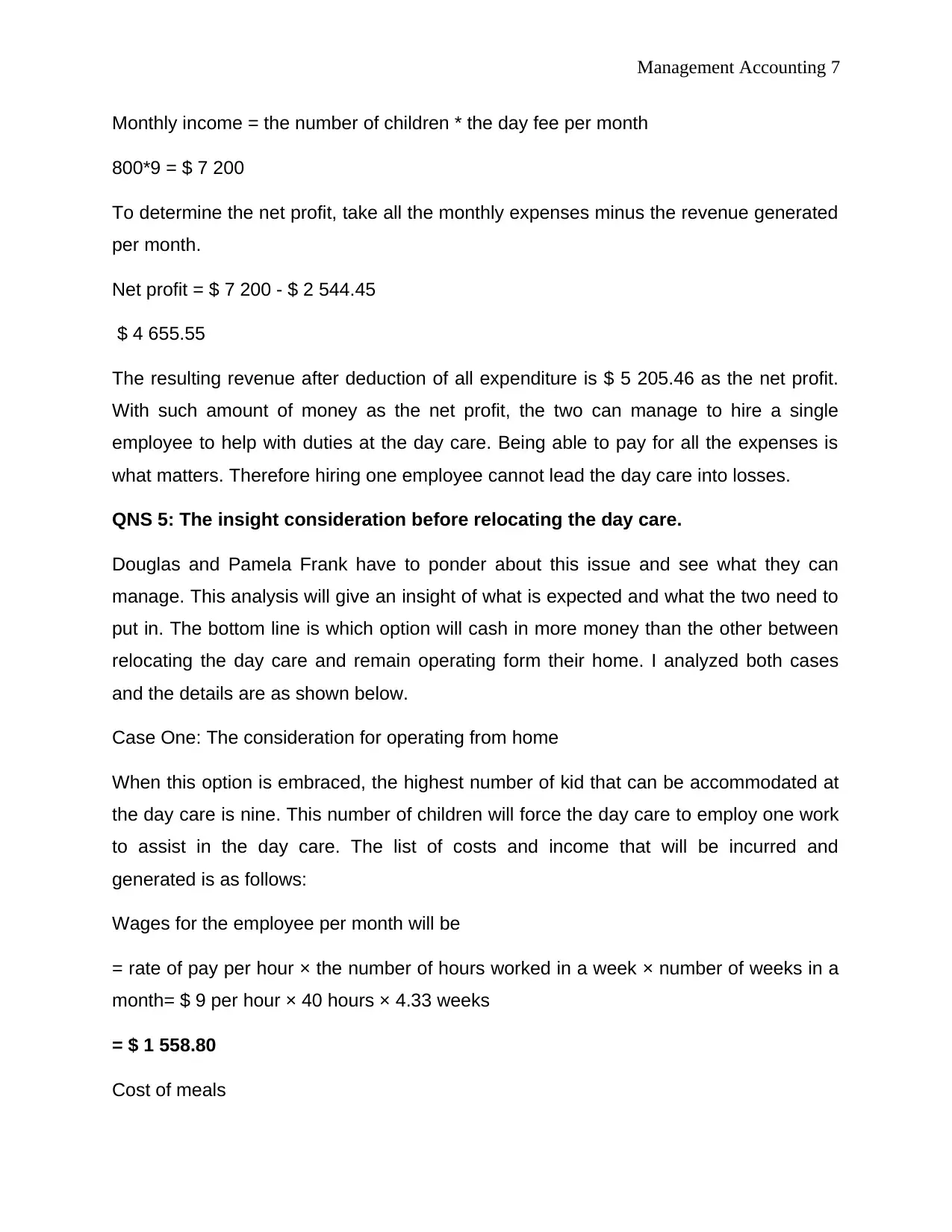
Management Accounting 7
Monthly income = the number of children * the day fee per month
800*9 = $ 7 200
To determine the net profit, take all the monthly expenses minus the revenue generated
per month.
Net profit = $ 7 200 - $ 2 544.45
$ 4 655.55
The resulting revenue after deduction of all expenditure is $ 5 205.46 as the net profit.
With such amount of money as the net profit, the two can manage to hire a single
employee to help with duties at the day care. Being able to pay for all the expenses is
what matters. Therefore hiring one employee cannot lead the day care into losses.
QNS 5: The insight consideration before relocating the day care.
Douglas and Pamela Frank have to ponder about this issue and see what they can
manage. This analysis will give an insight of what is expected and what the two need to
put in. The bottom line is which option will cash in more money than the other between
relocating the day care and remain operating form their home. I analyzed both cases
and the details are as shown below.
Case One: The consideration for operating from home
When this option is embraced, the highest number of kid that can be accommodated at
the day care is nine. This number of children will force the day care to employ one work
to assist in the day care. The list of costs and income that will be incurred and
generated is as follows:
Wages for the employee per month will be
= rate of pay per hour × the number of hours worked in a week × number of weeks in a
month= $ 9 per hour × 40 hours × 4.33 weeks
= $ 1 558.80
Cost of meals
Monthly income = the number of children * the day fee per month
800*9 = $ 7 200
To determine the net profit, take all the monthly expenses minus the revenue generated
per month.
Net profit = $ 7 200 - $ 2 544.45
$ 4 655.55
The resulting revenue after deduction of all expenditure is $ 5 205.46 as the net profit.
With such amount of money as the net profit, the two can manage to hire a single
employee to help with duties at the day care. Being able to pay for all the expenses is
what matters. Therefore hiring one employee cannot lead the day care into losses.
QNS 5: The insight consideration before relocating the day care.
Douglas and Pamela Frank have to ponder about this issue and see what they can
manage. This analysis will give an insight of what is expected and what the two need to
put in. The bottom line is which option will cash in more money than the other between
relocating the day care and remain operating form their home. I analyzed both cases
and the details are as shown below.
Case One: The consideration for operating from home
When this option is embraced, the highest number of kid that can be accommodated at
the day care is nine. This number of children will force the day care to employ one work
to assist in the day care. The list of costs and income that will be incurred and
generated is as follows:
Wages for the employee per month will be
= rate of pay per hour × the number of hours worked in a week × number of weeks in a
month= $ 9 per hour × 40 hours × 4.33 weeks
= $ 1 558.80
Cost of meals
Paraphrase This Document
Need a fresh take? Get an instant paraphrase of this document with our AI Paraphraser
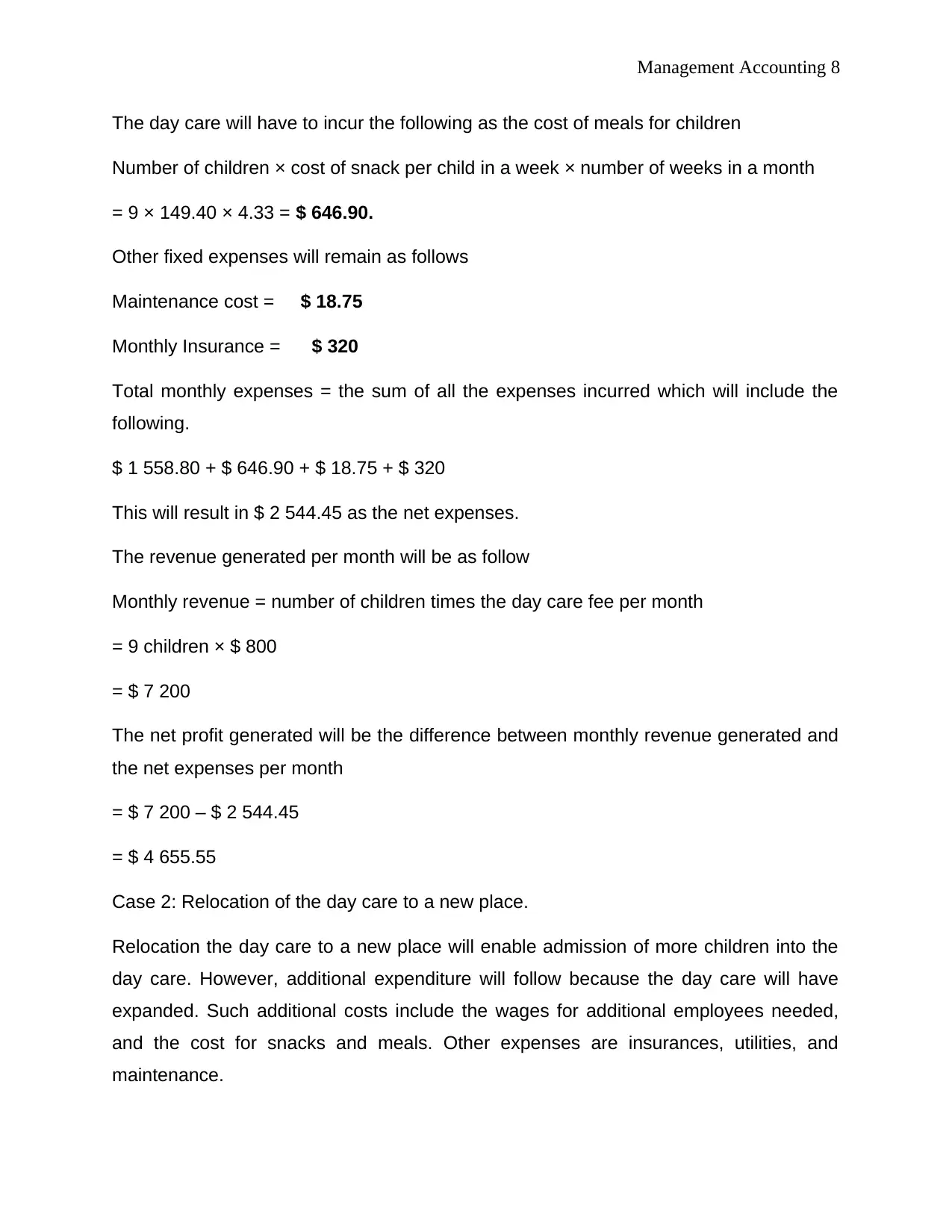
Management Accounting 8
The day care will have to incur the following as the cost of meals for children
Number of children × cost of snack per child in a week × number of weeks in a month
= 9 × 149.40 × 4.33 = $ 646.90.
Other fixed expenses will remain as follows
Maintenance cost = $ 18.75
Monthly Insurance = $ 320
Total monthly expenses = the sum of all the expenses incurred which will include the
following.
$ 1 558.80 + $ 646.90 + $ 18.75 + $ 320
This will result in $ 2 544.45 as the net expenses.
The revenue generated per month will be as follow
Monthly revenue = number of children times the day care fee per month
= 9 children × $ 800
= $ 7 200
The net profit generated will be the difference between monthly revenue generated and
the net expenses per month
= $ 7 200 – $ 2 544.45
= $ 4 655.55
Case 2: Relocation of the day care to a new place.
Relocation the day care to a new place will enable admission of more children into the
day care. However, additional expenditure will follow because the day care will have
expanded. Such additional costs include the wages for additional employees needed,
and the cost for snacks and meals. Other expenses are insurances, utilities, and
maintenance.
The day care will have to incur the following as the cost of meals for children
Number of children × cost of snack per child in a week × number of weeks in a month
= 9 × 149.40 × 4.33 = $ 646.90.
Other fixed expenses will remain as follows
Maintenance cost = $ 18.75
Monthly Insurance = $ 320
Total monthly expenses = the sum of all the expenses incurred which will include the
following.
$ 1 558.80 + $ 646.90 + $ 18.75 + $ 320
This will result in $ 2 544.45 as the net expenses.
The revenue generated per month will be as follow
Monthly revenue = number of children times the day care fee per month
= 9 children × $ 800
= $ 7 200
The net profit generated will be the difference between monthly revenue generated and
the net expenses per month
= $ 7 200 – $ 2 544.45
= $ 4 655.55
Case 2: Relocation of the day care to a new place.
Relocation the day care to a new place will enable admission of more children into the
day care. However, additional expenditure will follow because the day care will have
expanded. Such additional costs include the wages for additional employees needed,
and the cost for snacks and meals. Other expenses are insurances, utilities, and
maintenance.
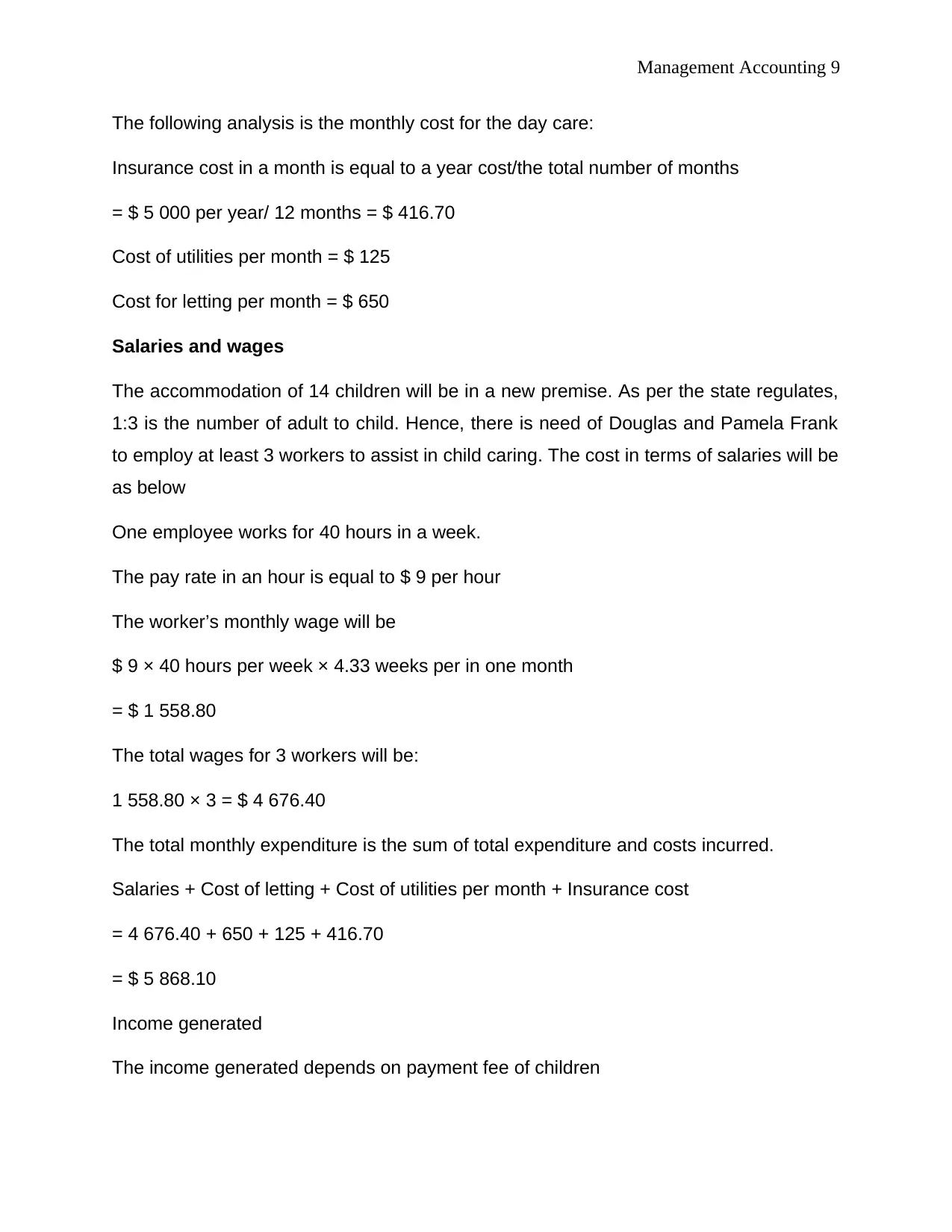
Management Accounting 9
The following analysis is the monthly cost for the day care:
Insurance cost in a month is equal to a year cost/the total number of months
= $ 5 000 per year/ 12 months = $ 416.70
Cost of utilities per month = $ 125
Cost for letting per month = $ 650
Salaries and wages
The accommodation of 14 children will be in a new premise. As per the state regulates,
1:3 is the number of adult to child. Hence, there is need of Douglas and Pamela Frank
to employ at least 3 workers to assist in child caring. The cost in terms of salaries will be
as below
One employee works for 40 hours in a week.
The pay rate in an hour is equal to $ 9 per hour
The worker’s monthly wage will be
$ 9 × 40 hours per week × 4.33 weeks per in one month
= $ 1 558.80
The total wages for 3 workers will be:
1 558.80 × 3 = $ 4 676.40
The total monthly expenditure is the sum of total expenditure and costs incurred.
Salaries + Cost of letting + Cost of utilities per month + Insurance cost
= 4 676.40 + 650 + 125 + 416.70
= $ 5 868.10
Income generated
The income generated depends on payment fee of children
The following analysis is the monthly cost for the day care:
Insurance cost in a month is equal to a year cost/the total number of months
= $ 5 000 per year/ 12 months = $ 416.70
Cost of utilities per month = $ 125
Cost for letting per month = $ 650
Salaries and wages
The accommodation of 14 children will be in a new premise. As per the state regulates,
1:3 is the number of adult to child. Hence, there is need of Douglas and Pamela Frank
to employ at least 3 workers to assist in child caring. The cost in terms of salaries will be
as below
One employee works for 40 hours in a week.
The pay rate in an hour is equal to $ 9 per hour
The worker’s monthly wage will be
$ 9 × 40 hours per week × 4.33 weeks per in one month
= $ 1 558.80
The total wages for 3 workers will be:
1 558.80 × 3 = $ 4 676.40
The total monthly expenditure is the sum of total expenditure and costs incurred.
Salaries + Cost of letting + Cost of utilities per month + Insurance cost
= 4 676.40 + 650 + 125 + 416.70
= $ 5 868.10
Income generated
The income generated depends on payment fee of children
⊘ This is a preview!⊘
Do you want full access?
Subscribe today to unlock all pages.

Trusted by 1+ million students worldwide
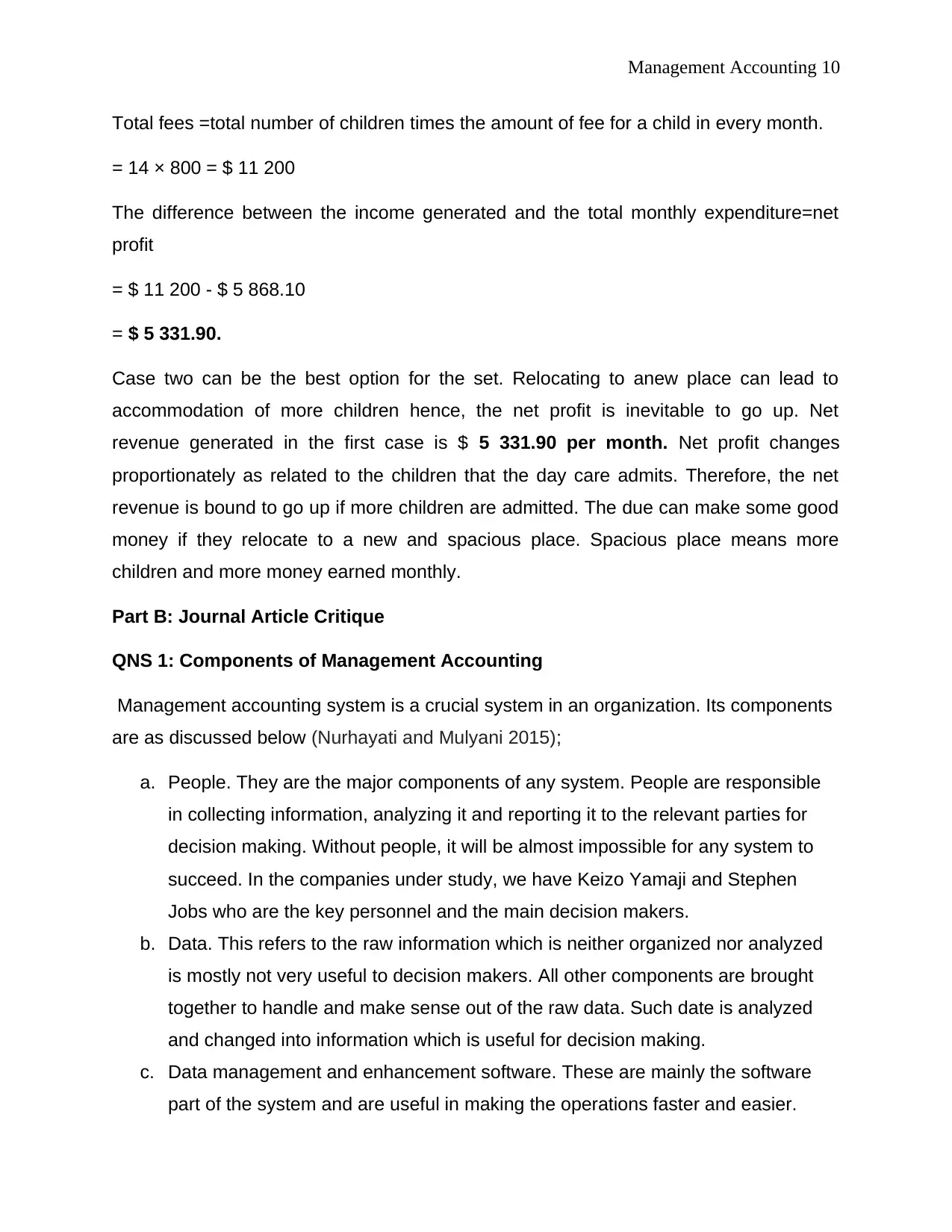
Management Accounting 10
Total fees =total number of children times the amount of fee for a child in every month.
= 14 × 800 = $ 11 200
The difference between the income generated and the total monthly expenditure=net
profit
= $ 11 200 - $ 5 868.10
= $ 5 331.90.
Case two can be the best option for the set. Relocating to anew place can lead to
accommodation of more children hence, the net profit is inevitable to go up. Net
revenue generated in the first case is $ 5 331.90 per month. Net profit changes
proportionately as related to the children that the day care admits. Therefore, the net
revenue is bound to go up if more children are admitted. The due can make some good
money if they relocate to a new and spacious place. Spacious place means more
children and more money earned monthly.
Part B: Journal Article Critique
QNS 1: Components of Management Accounting
Management accounting system is a crucial system in an organization. Its components
are as discussed below (Nurhayati and Mulyani 2015);
a. People. They are the major components of any system. People are responsible
in collecting information, analyzing it and reporting it to the relevant parties for
decision making. Without people, it will be almost impossible for any system to
succeed. In the companies under study, we have Keizo Yamaji and Stephen
Jobs who are the key personnel and the main decision makers.
b. Data. This refers to the raw information which is neither organized nor analyzed
is mostly not very useful to decision makers. All other components are brought
together to handle and make sense out of the raw data. Such date is analyzed
and changed into information which is useful for decision making.
c. Data management and enhancement software. These are mainly the software
part of the system and are useful in making the operations faster and easier.
Total fees =total number of children times the amount of fee for a child in every month.
= 14 × 800 = $ 11 200
The difference between the income generated and the total monthly expenditure=net
profit
= $ 11 200 - $ 5 868.10
= $ 5 331.90.
Case two can be the best option for the set. Relocating to anew place can lead to
accommodation of more children hence, the net profit is inevitable to go up. Net
revenue generated in the first case is $ 5 331.90 per month. Net profit changes
proportionately as related to the children that the day care admits. Therefore, the net
revenue is bound to go up if more children are admitted. The due can make some good
money if they relocate to a new and spacious place. Spacious place means more
children and more money earned monthly.
Part B: Journal Article Critique
QNS 1: Components of Management Accounting
Management accounting system is a crucial system in an organization. Its components
are as discussed below (Nurhayati and Mulyani 2015);
a. People. They are the major components of any system. People are responsible
in collecting information, analyzing it and reporting it to the relevant parties for
decision making. Without people, it will be almost impossible for any system to
succeed. In the companies under study, we have Keizo Yamaji and Stephen
Jobs who are the key personnel and the main decision makers.
b. Data. This refers to the raw information which is neither organized nor analyzed
is mostly not very useful to decision makers. All other components are brought
together to handle and make sense out of the raw data. Such date is analyzed
and changed into information which is useful for decision making.
c. Data management and enhancement software. These are mainly the software
part of the system and are useful in making the operations faster and easier.
Paraphrase This Document
Need a fresh take? Get an instant paraphrase of this document with our AI Paraphraser
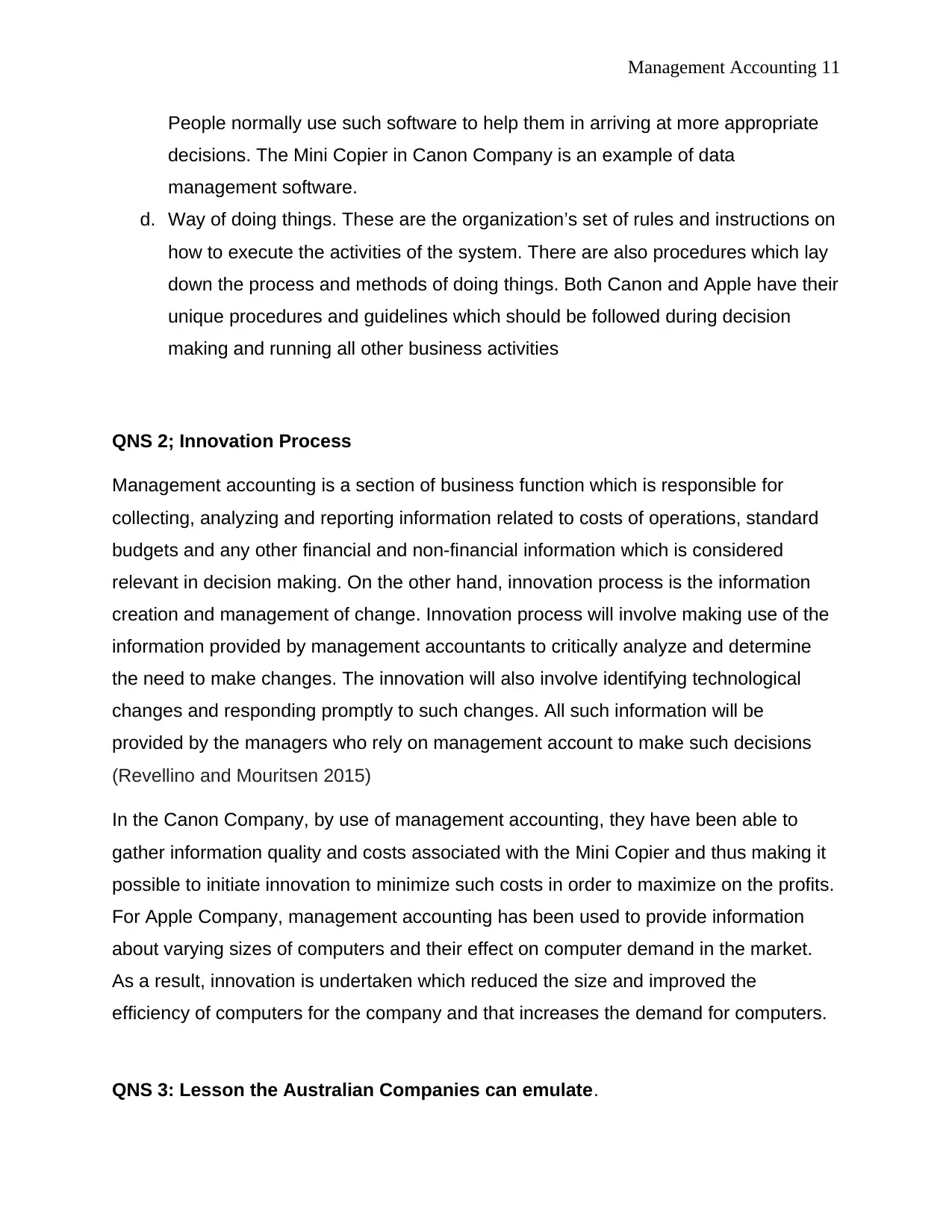
Management Accounting 11
People normally use such software to help them in arriving at more appropriate
decisions. The Mini Copier in Canon Company is an example of data
management software.
d. Way of doing things. These are the organization’s set of rules and instructions on
how to execute the activities of the system. There are also procedures which lay
down the process and methods of doing things. Both Canon and Apple have their
unique procedures and guidelines which should be followed during decision
making and running all other business activities
QNS 2; Innovation Process
Management accounting is a section of business function which is responsible for
collecting, analyzing and reporting information related to costs of operations, standard
budgets and any other financial and non-financial information which is considered
relevant in decision making. On the other hand, innovation process is the information
creation and management of change. Innovation process will involve making use of the
information provided by management accountants to critically analyze and determine
the need to make changes. The innovation will also involve identifying technological
changes and responding promptly to such changes. All such information will be
provided by the managers who rely on management account to make such decisions
(Revellino and Mouritsen 2015)
In the Canon Company, by use of management accounting, they have been able to
gather information quality and costs associated with the Mini Copier and thus making it
possible to initiate innovation to minimize such costs in order to maximize on the profits.
For Apple Company, management accounting has been used to provide information
about varying sizes of computers and their effect on computer demand in the market.
As a result, innovation is undertaken which reduced the size and improved the
efficiency of computers for the company and that increases the demand for computers.
QNS 3: Lesson the Australian Companies can emulate.
People normally use such software to help them in arriving at more appropriate
decisions. The Mini Copier in Canon Company is an example of data
management software.
d. Way of doing things. These are the organization’s set of rules and instructions on
how to execute the activities of the system. There are also procedures which lay
down the process and methods of doing things. Both Canon and Apple have their
unique procedures and guidelines which should be followed during decision
making and running all other business activities
QNS 2; Innovation Process
Management accounting is a section of business function which is responsible for
collecting, analyzing and reporting information related to costs of operations, standard
budgets and any other financial and non-financial information which is considered
relevant in decision making. On the other hand, innovation process is the information
creation and management of change. Innovation process will involve making use of the
information provided by management accountants to critically analyze and determine
the need to make changes. The innovation will also involve identifying technological
changes and responding promptly to such changes. All such information will be
provided by the managers who rely on management account to make such decisions
(Revellino and Mouritsen 2015)
In the Canon Company, by use of management accounting, they have been able to
gather information quality and costs associated with the Mini Copier and thus making it
possible to initiate innovation to minimize such costs in order to maximize on the profits.
For Apple Company, management accounting has been used to provide information
about varying sizes of computers and their effect on computer demand in the market.
As a result, innovation is undertaken which reduced the size and improved the
efficiency of computers for the company and that increases the demand for computers.
QNS 3: Lesson the Australian Companies can emulate.
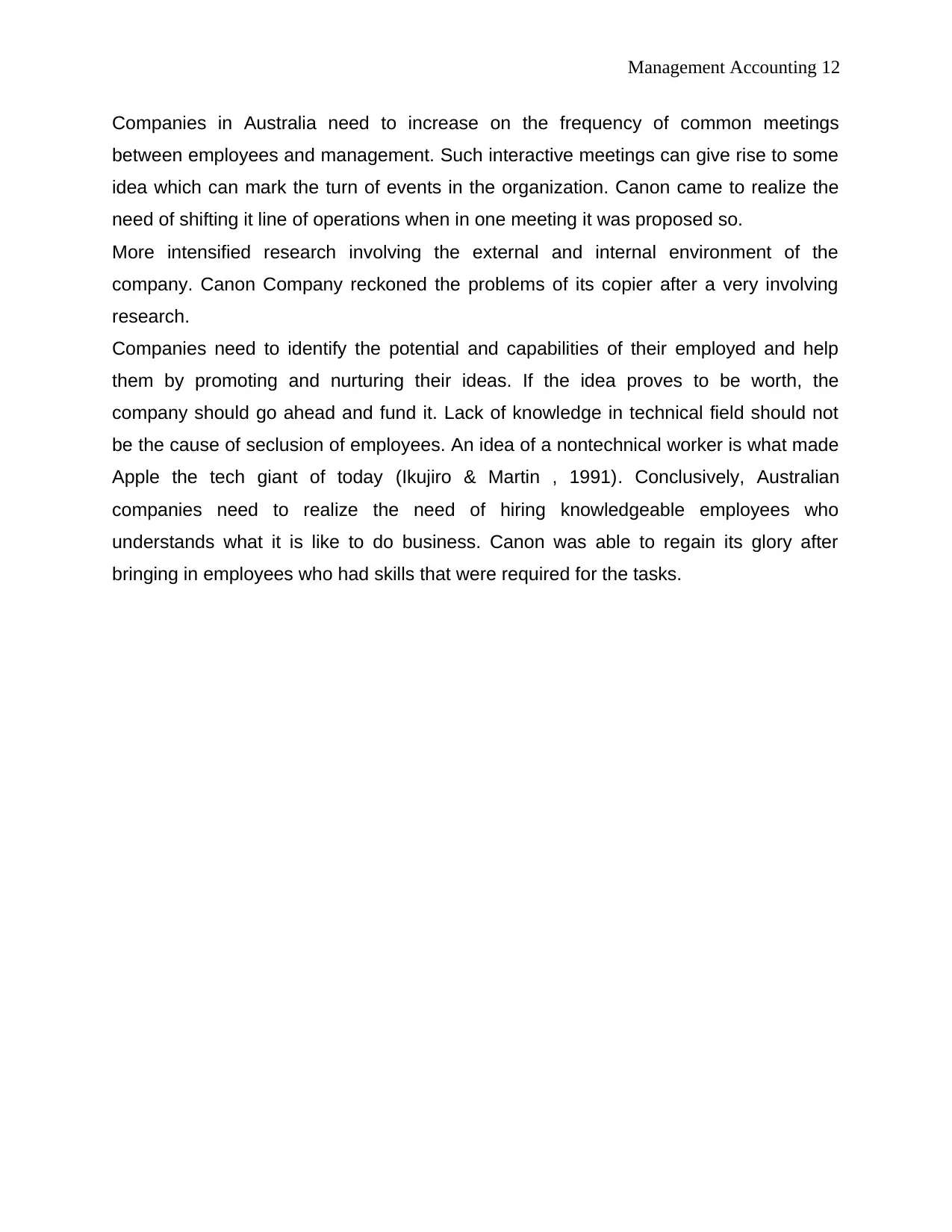
Management Accounting 12
Companies in Australia need to increase on the frequency of common meetings
between employees and management. Such interactive meetings can give rise to some
idea which can mark the turn of events in the organization. Canon came to realize the
need of shifting it line of operations when in one meeting it was proposed so.
More intensified research involving the external and internal environment of the
company. Canon Company reckoned the problems of its copier after a very involving
research.
Companies need to identify the potential and capabilities of their employed and help
them by promoting and nurturing their ideas. If the idea proves to be worth, the
company should go ahead and fund it. Lack of knowledge in technical field should not
be the cause of seclusion of employees. An idea of a nontechnical worker is what made
Apple the tech giant of today (Ikujiro & Martin , 1991). Conclusively, Australian
companies need to realize the need of hiring knowledgeable employees who
understands what it is like to do business. Canon was able to regain its glory after
bringing in employees who had skills that were required for the tasks.
Companies in Australia need to increase on the frequency of common meetings
between employees and management. Such interactive meetings can give rise to some
idea which can mark the turn of events in the organization. Canon came to realize the
need of shifting it line of operations when in one meeting it was proposed so.
More intensified research involving the external and internal environment of the
company. Canon Company reckoned the problems of its copier after a very involving
research.
Companies need to identify the potential and capabilities of their employed and help
them by promoting and nurturing their ideas. If the idea proves to be worth, the
company should go ahead and fund it. Lack of knowledge in technical field should not
be the cause of seclusion of employees. An idea of a nontechnical worker is what made
Apple the tech giant of today (Ikujiro & Martin , 1991). Conclusively, Australian
companies need to realize the need of hiring knowledgeable employees who
understands what it is like to do business. Canon was able to regain its glory after
bringing in employees who had skills that were required for the tasks.
⊘ This is a preview!⊘
Do you want full access?
Subscribe today to unlock all pages.

Trusted by 1+ million students worldwide
1 out of 16
Related Documents
Your All-in-One AI-Powered Toolkit for Academic Success.
+13062052269
info@desklib.com
Available 24*7 on WhatsApp / Email
![[object Object]](/_next/static/media/star-bottom.7253800d.svg)
Unlock your academic potential
Copyright © 2020–2025 A2Z Services. All Rights Reserved. Developed and managed by ZUCOL.





